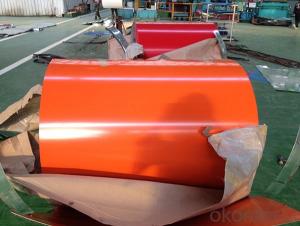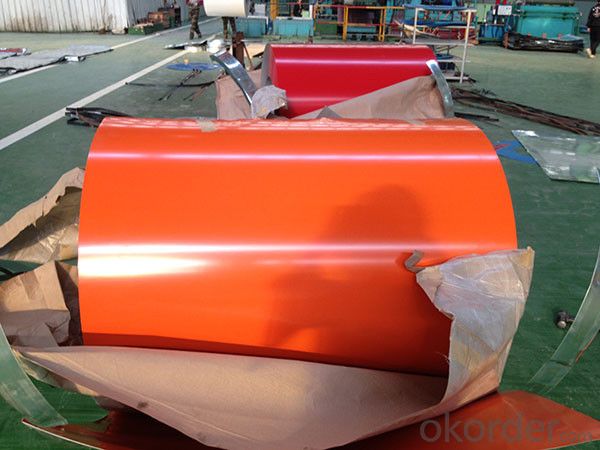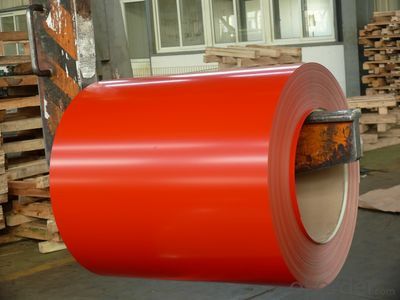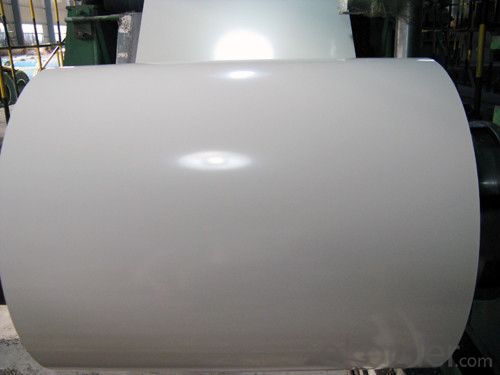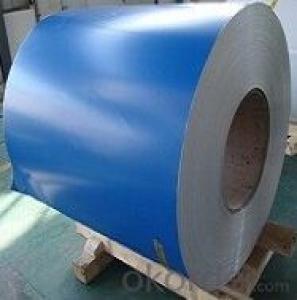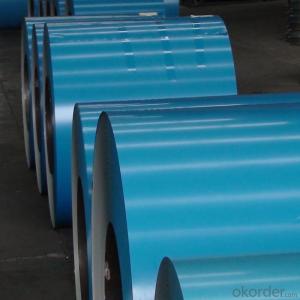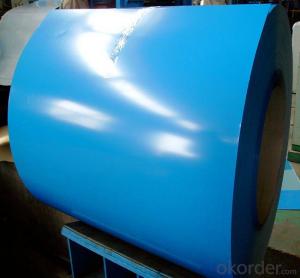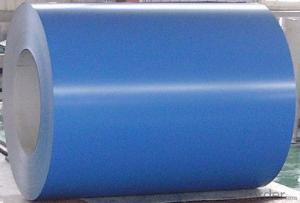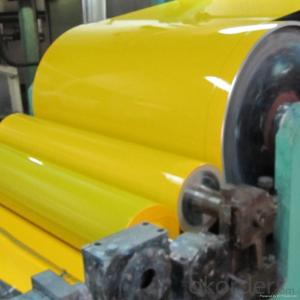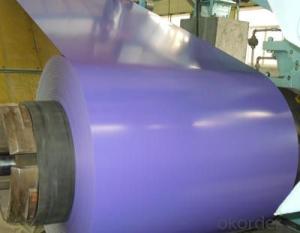Prepainted aluminum zinc Rolled Coil for Construction Roof
- Loading Port:
- Shanghai
- Payment Terms:
- TT OR LC
- Min Order Qty:
- 25 m.t.
- Supply Capability:
- 30000 m.t./month
OKorder Service Pledge
OKorder Financial Service
You Might Also Like
Structure of Aluminum Zinc Rolled Coil

Description of Aluminum Zinc Rolled Coil
Aluminum zinc coils is a kind of coated steel coil/sheet. With the cold rolled steel of different strength and thickness as substrate, it is produced through applying Al-Zn coat on both faces by hot dip process. In its coating, Al accounts for about 55%, Si 1.6%, while the remaining is Zn. Aluminum zinc coils enjoys both the physical protective feature and durability of Al and the electrochemical protective property of Zn. And its surface has bright silver color and regular embossed-like figure, which are highly decorative.
Main Feature of Aluminum Zinc Rolled Coil for Construction Roof
1.Corrosion resistance: It mainly depends on the aluminum protection. When the zinc being worn, the aluminum will form a dense layer of aluminum oxide, resist corrosion material to prevent further corrosion inside.
2. Heat resistance: Aluminum zinc alloy steel sheet has excellent heat resistance, can withstand high temperatures over 300 centigrade, and is similar with aluminized steel high temperature oxidation resistance. It often used in chimney pipes, ovens, fluorescent lighting device and the device cover.
3. Heat reflective: Galvanized steel plate heat-reflective high rate is twice as galvanized steel, often used to make insulation materials.
4. Economy: Because density of 55% AL-Zn is smaller than the density of Zn, so in the same weight and thickness of Galvanized zinc layer, aluminum-zinc steel plate is larger area more than 3% of galvanized steel sheet.
Applications of Aluminum Zinc Rolled Coil for Construction Roof
1. Construction and building: roofing; ventilating duct; handrail; partition panel;etc.
2. Electric appliance: refrigerator; washing machine; refrigerator; DVD;etc.
3.Transportation: oil tank; road sign; etc.
4.Agriculture:barn; etc.
5.Others:vending machine; game machine; etc.
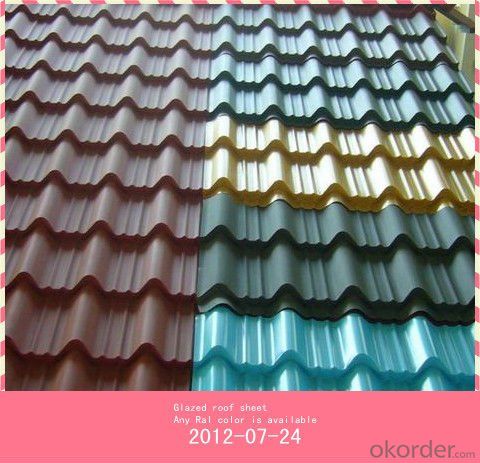
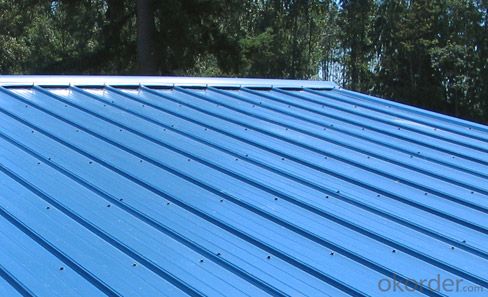
Prepainted Aluminum Zinc Rolled Coil for Construction Images
Specifications of Prepainted Aluminum Zinc Rolled Coil for Construction
Chemical Composition | ||||||
GRADE | C | Si | Mn | P | S | Ti |
SGCC/DX51D+Z | ≤0.10 | ≤0.50 | ≤0.60 | ≤0.10 | ≤0.030 | ≤0.020 |
DX52D+Z | ≤0.10 | ≤0.50 | ≤0.60 | ≤0.10 | ≤0.030 | ≤0.020 |
SGCD/DX53D+Z | ≤0.10 | ≤0.30 | ≤0.50 | ≤0.05 | ≤0.030 | ≤0.020 |
SGCE/DX54D+Z | ≤0.10 | ≤0.30 | ≤0.30 | ≤0.03 | ≤0.020 | ≤0.020 |
DX56D+Z | ≤0.10 | ≤0.30 | ≤0.30 | ≤0.03 | ≤0.020 | ≤0.020 |
Structural | ≤0.20 | ≤0.60 | ≤1.70 | ≤0.10 | ≤0.045 | |
Mechanical Properties | ||||||
GRADE | Yield Strength MPa | Tensile Strength MPa | Elongation % | |||
SGCC(DX51D+Z) | ≥205 | ≥270 | - | |||
SGCD(DX53D+Z) | - | ≥270 | 38 | |||
SGCE(DX54D+Z) | - | ≥270 | 40 | |||
DX56D+Z | - | ≥270 | 42 | |||
FAQ of Prepainted Aluminum Zinc Rolled Coil for Construction
We have organized several common questions for our clients,may help you sincerely:
1. What is the minimum order quantity ?
Our MOQ is 50mt for each size. And we will consider to give more discount if you make big order like 1000 tons and more. Further more, the more appropriate payment term your offer the better price we can provide.
2. How long can we receive the product after purchase?
Usually within thirty working days after receiving buyer’s advance payment or LC. We will arrange the factory manufacturing as soon as possible. The cargo readiness usually takes 15-25 days, but the shipment will depend on the vessel situation.
3. How to guarantee the quality of the products?
We have established the international advanced quality management system,every link from raw material to final product we have strict quality test;We resolutely put an end to unqualified products flowing into the market. At the same time, we will provide necessary follow-up service assurance.
- Q: What are the different types of edge treatments for steel coils?
- Steel coils can undergo different edge treatments, each serving a specific purpose and offering unique benefits. 1. The most commonly used edge treatment is the slit edge. This involves cutting the coil along its width, resulting in two distinct edges. Slit edges are usually smooth and free from burrs, making them suitable for most applications. 2. The mill edge is the untreated edge of a steel coil straight from the rolling mill. It has a rough and uneven surface with visible imperfections like burrs and irregularities. Mill edges are generally not suitable for direct use and require further processing or trimming to achieve the desired edge quality. 3. The trimmed edge is a treatment that involves removing the rough and irregular portions of the mill edge. This is done through shearing or cutting, resulting in a smoother and more consistent edge. Trimmed edges are commonly used when a clean and uniform appearance is required. 4. Deburred edge refers to the process of removing any sharp or rough edges from the steel coil. This treatment is crucial for applications where safety is a concern as it eliminates the risk of injuries from handling sharp edges. Deburred edges are achieved through grinding or filing and provide a smooth and safe edge for various applications. 5. Rounded edge is a treatment that involves rounding the sharp corners of the steel coil. This is done to prevent damage to other materials or surfaces during handling or transportation. Rounded edges reduce the risk of scratches, dents, or other forms of surface damage. 6. Beveled edge is a treatment where the edge of the steel coil is cut at an angle, typically 45 degrees. This treatment is commonly used in applications that require a tight fit or seamless joint with other components. Beveled edges allow for easier assembly and improve the overall appearance of the final product. Each of these edge treatments offers its own advantages and is chosen based on the specific requirements of the application. Choosing the right edge treatment for steel coils is crucial to ensure optimal performance, safety, and aesthetics in industries such as construction, manufacturing, automotive, and more.
- Q: Can steel coils be used in the production of aerospace components?
- Indeed, the utilization of steel coils is feasible for the manufacturing of aerospace components. Steel, being a robust and adaptable substance, possesses an outstanding ratio of strength to weight, rendering it appropriate for a multitude of purposes in the aerospace sector. The processing and manipulation of steel coils allow for the fulfillment of precise specifications, including the creation of intricate components, structural elements, and even utilization in aerospace engines. Moreover, the corrosion resistance characteristics and capability to endure extreme temperatures make steel a dependable selection for aerospace applications.
- Q: I'm looking to buy the Milano Stiletto, and it uses 1045 steel. I was just wondering whether this will hold up and keep an edge.
- This Site Might Help You. RE: Is 1045 steel pretty good for a knife blade? I'm looking to buy the Milano Stiletto, and it uses 1045 steel. I was just wondering whether this will hold up and keep an edge.
- Q: How are steel coils used in the manufacturing of construction scaffolding?
- Steel coils are used in the manufacturing of construction scaffolding as they provide the necessary strength and durability required for the structures. These coils are generally processed and shaped into various components, such as pipes, tubes, and frames, which form the main structure of the scaffolding. The high tensile strength of steel coils ensures that the scaffolding can support heavy loads and provide a safe working platform for workers at construction sites.
- Q: How are steel coils used in the manufacturing of building materials?
- Steel coils are used in the manufacturing of building materials as they provide a strong and durable base for various products. These coils are typically unrolled and shaped into different forms, such as sheets or beams, which are then used to create structures like roofing, siding, and framing. The flexibility and strength of steel make it an ideal material for construction purposes, ensuring buildings are sturdy and long-lasting.
- Q: How are steel coils handled during loading and unloading?
- Steel coils are typically handled using cranes, forklifts, or coil hooks during loading and unloading. The coils are carefully lifted, secured, and transported to their respective destinations. Special attention is paid to ensure proper balance, stability, and safety measures are followed to prevent any damage or accidents during the process.
- Q: i know stainless steel swords are decoration, what metal is ok for a sword that is usable
- carbon steel will hold a good edge, but will corrode easily. The nicest blades I have seen are made from damascus steel (repeatedly folded over and over). It makes a blade which is good and flexible sideways, but more rigid in the cutting direction, and it holds an edge extremely well. It also looks awesome due to the grain effect from the folds, but is very expensive.
- Q: How are steel coils used in the production of rail tracks?
- Steel coils are used in the production of rail tracks as they are a primary raw material for manufacturing the rails. These coils are first processed to form the desired shape and dimensions of the rail tracks, which are then cut, welded, and shaped to create the individual rail sections. The steel coils provide the strength, durability, and flexibility necessary for the tracks to withstand heavy loads, extreme weather conditions, and constant use.
- Q: I know that steel wool is coated with... something... that protects it from rusting. I need to know what that is, and how to get it off.
- spun steel fibers have a microscopic coating of oil to prevent them from rusting. Rusting steel wool wouldn't sell very well. I would think that removing this oil could be accomplished with any good degreaser, like brake cleaner or the like. However, I've never tried this before. In science class they perform experiments by removing the oil with vinegar. After wringing out the steel wool pad, it is wrapped around a thermometer and placed in a sealed jar. After a few minutes the temperature rises because of the chemical reaction that takes place when four atoms of iron react with three atoms of oxygen and create two atoms of iron oxide - RUST! You can unwittingly recreate this experiment by using steel wool in the process of removing one or more layers of finish from a piece of furniture Hope this helps
- Q: What are the common applications of hot-rolled steel coils?
- Hot-rolled steel coils are widely used in various industries due to their unique characteristics and versatility. Some of the common applications of hot-rolled steel coils include: 1. Automotive industry: Hot-rolled steel coils are extensively used in the automotive sector for manufacturing various components like frames, doors, hoods, wheels, and chassis. The high strength and formability of hot-rolled steel make it an ideal choice for producing durable and lightweight automotive parts. 2. Construction sector: Hot-rolled steel coils are widely used in construction projects for manufacturing structural components like beams, columns, and trusses. The high strength and ductility of hot-rolled steel make it suitable for withstanding heavy loads and providing structural stability. 3. Manufacturing industry: Hot-rolled steel coils find applications in the manufacturing sector for producing a wide range of products including machinery parts, pipes, tubes, and equipment. The excellent machinability and weldability of hot-rolled steel allow for easy fabrication and customization according to specific manufacturing requirements. 4. Energy sector: Hot-rolled steel coils are used in the energy sector for manufacturing pipelines, tanks, and other infrastructure required for oil and gas exploration, transmission, and storage. The corrosion resistance and strength of hot-rolled steel make it a preferred choice for such applications. 5. Appliances and furniture industry: Hot-rolled steel coils are used in the manufacturing of appliances like refrigerators, ovens, and washing machines, as well as for producing furniture components like frames and supports. The aesthetic appeal, durability, and cost-effectiveness of hot-rolled steel make it a popular choice in these industries. 6. Shipbuilding industry: Hot-rolled steel coils are extensively used in the shipbuilding sector for constructing various components like hulls, decks, and bulkheads. The high tensile strength and corrosion resistance of hot-rolled steel ensure the durability and longevity of ships in harsh marine environments. 7. Infrastructure and bridge construction: Hot-rolled steel coils are used in the construction of bridges, highways, and other infrastructure projects. The high strength and load-bearing capacity of hot-rolled steel make it suitable for supporting heavy traffic and withstanding dynamic loads. In summary, hot-rolled steel coils find applications in various industries including automotive, construction, manufacturing, energy, appliances and furniture, shipbuilding, and infrastructure. The unique properties of hot-rolled steel, such as high strength, formability, and versatility, make it an indispensable material for a wide range of applications.
Send your message to us
Prepainted aluminum zinc Rolled Coil for Construction Roof
- Loading Port:
- Shanghai
- Payment Terms:
- TT OR LC
- Min Order Qty:
- 25 m.t.
- Supply Capability:
- 30000 m.t./month
OKorder Service Pledge
OKorder Financial Service
Similar products
Hot products
Hot Searches
Related keywords
